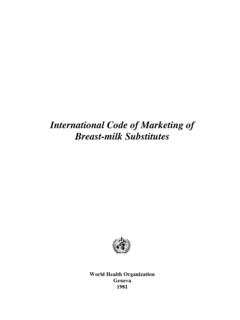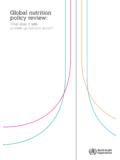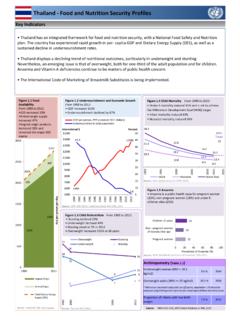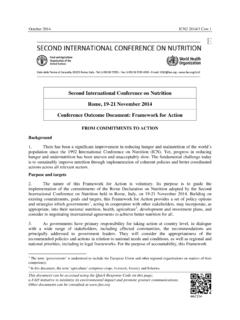Transcription of BFHI Section 2 Final 14May09 - World Health …
1 Session 1:The national infant feeding situationSlide on infant and young child feeding About 2 million child deaths could be prevented every year through optimal breastfeeding. Exclusively breastfed infants have at least 2 times fewer illness episodes than infants fed breast-milk substitutes. Infants are as much as 25 times more likely to die from diarrhoea in the first 6 months of life if not exclusively breastfed. Among children under one year, those who are not breastfed are 3 times more likely to die of respiratory infection than those who are exclusively : Jones et al., 2003; Chandra, 1979; Feachem, 1984; and Victora, on infant and young child feeding Infants exclusively breastfed for 4 or more months have half the mean number of acute otitis media episodes of those not breastfed at all. In low-income communities, the cost of cow s milk or powdered milk, plus bottles, teats, and fuel for boiling water, can consume 25 to 50% of a family s income.
2 Breastfeeding contributes to natural birth spacing, providing 30% more protection against pregnancy than all the organized family planning programmes in the developing : Duncan et al, 1993; UNICEF/WHO/UNESCO/UNFPAA, 1993; and Kleinman, on infant and young child feeding The peak period of malnutrition is between 6 and 28 months of age. Malnutrition contributes to about half of under-five mortality and a third of this is due to faulty feeding practices. Counselling on breastfeeding and complementary feeding leads to improved feeding practices, improved intakes and growth. Counselling on breastfeeding and complementary feeding contributes to lowering the incidence of s infant and young child feeding recommendations Initiate breastfeeding within one hour of birth. Breastfeed exclusively for the first six months of age (180 days).
3 Thereafter give nutritionally adequate and safe complementary foods to all children. Continue breastfeeding for up to two years of age or from the Global and complementary feeding terms and definitions EXCLUSIVE BREASTFEEDING:the infant takes only breast milk and no additional food, water, or other fluids with the exception of medicines and vitamin or mineral drops. PARTIAL BREASTFEEDING or MIXED feeding :the infant is given some breast feeds and some artificial feeds, either milk or cereal, or other food or water. BOTTLE- feeding :the infant is feeding from a bottle, regardless of its contents, including expressed breast and complementary feeding terms and definitions ARTIFICIAL feeding :the infant is given breast-milk substitutes and not breastfeeding at all. REPLACEMENT feeding :the process of feeding a child of an HIV-positive mother who is not receiving any breast milk with a diet that provides all the nutrients the child needs.
4 COMPLEMENTARY feeding :the process of giving an infant food in addition to breast milk or infant formula, when either becomes insufficient to satisfy the infant 's nutritional questions to compare the country situation with WHO infant and young child feeding recommendations Percentage of infants breastfeeding exclusively for the first six months of life (180 days) Percentage of infants with continued breastfeeding at 1 year Percentage of infants that introduced solid, semi-solid and soft foods at 6 months Percentage of children with minimum dietary diversity Percentage of children with minimum meal frequencySlide questions to compare Health facility data with WHO recommendations Early initiation:percentage of babies who start breastfeeding within 1 hour of birth Rooming-in:percentage of babies who room-in on a 24-hour basis with their mothers after delivery Exclusive breastfeeding:percentage of babies who are exclusively breastfed from birth to discharge Bottle- feeding :percentage of babies who are getting any feeds from bottles between birth and dischargeSession 2:The benefits of breastfeedingSlide 2aBenefits of breastfeeding for the infant Provides superior nutrition for optimum growth.
5 Provides adequate water for hydration. Protects against infection and allergies. Promotes bonding and of differences between milksHuman milkAnimal milksInfant formulaProteincorrect amount, easy to digesttoo much, difficult to digestpartly correctedFatenough essential fatty acids, lipase to digestlacks essential fatty acids, no lipaseno lipaseWaterenoughextra neededmay need extraAnti-infective propertiespresentabsentabsentAdapted from: Breastfeeding counselling: A training course. Geneva, World Health Organization, 1993 (WHO/ ).Slide water necessaryCountry Temperature C Relative Humidity % Urine osmolarity (mOsm/l) Argentina 20-39 60-80 105-199 India 27-42 10-60 66-1234 Jamaica 24-28 62-90 103-468 Peru 24-30 45-96 30-544 (normal osmolarity: 50-1400 mOsm/l) Adapted from.
6 Breastfeeding and the use of water and , World Health Organization, milk composition differences (dynamic) Gestational age at birth(preterm and full term) Stage of lactation(colostrum and mature milk) During a feed(foremilk and hindmilk)Slide 2bSlide 2cColostrumProperty Antibody-rich Many white cells Purgative Growth factors Vitamin-A richImportance Protects against infection and allergy Protects against infection Clears meconium; helps prevent jaundice Helps intestine mature; prevents allergy, intolerance Reduces severity of some infection (such as measles and diarrhoea); prevents vitamin A-related eye diseasesSlide milk in second year of life31%38%45%95%0%20%40%60%80%100%Energy ProteinVitamin AVitamin C%dailyneedsprovidedby500 mlbreastmilkFrom: Breastfeeding counselling: A training course. Geneva, World Health Organization, 1993 (WHO/ ).
7 Slide effect of breastfeeding on infant morbiditySlide 2dRisk of diarrhoea by feeding methodfor infants aged 0-2 months, milk onlyBreast milk &non-nutritiousliquidsBreast milk &nutritioussupplementsNo breast milkAdapted from: Popkin BM, Adair L, Akin JS, Black R, et al. Breastfeeding and diarrheal morbidity. Pediatrics, 1990, 86(6): of babies bottle-fed and breastfed for the first 13 weeks that had diarrhoeal illness at various weeks of age during the first year, of diarrhoeal illness by age in weeksPercent with diarrhoeaBottle-fedBreastfedAdapted from: Howie PW, Forsyth JS, Ogston SA, Clark A, Florey CV. Protective effect of breastfeeding against infection. Br Med J, 1990, 300: of infants 2-7 months of age reported as experiencing diarrhoea, by feeding category in the preceding month in the milkonly (100) Highmixed (89-99)MiddleMixed (58-88)Low mixed (1-57)Formulaonly (0)PercentDiarrhoeaAdapted from: Scariati PD, Grummer-Strawn LM, Fein SB.
8 A longitudinal analysis of infant morbidity and the extent of breastfeeding in the United States. Pediatrics, 1997, 99(6).Slide of babies bottle-fed and breastfed for the first 13 weeks that had respiratory illness at various weeks of age during the first year, of respiratory illness by age in weeksPercent with respiratory illnessBottle-fedBreastfedAdapted from: Howie PW, Forsyth JS, Ogston SA, Clark A, Florey CV. Protective effect of breastfeeding against infection. Br Med J, 1990, 300: of acute otitis media in relation to feeding pattern and age, Sweden14571361420051015201-34-78-12month sPercent with acute otitis mediabreastfedmixed fedweanedAdapted from: Aniansson G, Alm B, Andersson B, Hakansson A et al. A prospective coherent study on breast- feeding and otitis media in Swedish infants. Pediat Infect Dis J, 1994,13: of infants 2-7 months of age reported as experiencing ear infections, by feeding category in the preceding month in the only(100)Highmixed (89-99)Middlemixed (58-88)Low mixed(1-57)Formulaonly (0)PercentEar InfectionAdapted from: Scariati PD, Grummer-Strawn LM, Fein SB.
9 A longitudinal analysis of infant morbidity and the extent of breastfeeding in the United States. Pediatrics, 1997, 99(6).Slide effect of breastfeeding on infant mortalitySlide risks of death from diarrhoeal disease by age and breastfeeding category in Latin 0-3 moDiarrhoea 4-11 moexclusivebreastfeedingpartialbreastfee dingno breastfeedingAdapted from: Betran AP, de Onis M, Lauer JA, Villar J. Ecological study of effect of breast feeding on infant mortality in Latin America. BMJ, 2001, 323: risks of death from acute respiratory infections by age and breastfeeding category in Latin 0-3 mo4-11 moexclusivebreastfeedingpartialbreastfee dingno breastfeedingAdapted from: Betran AP, de Onis M, Lauer JA, Villar J. Ecological study of effect of breast feeding on infant mortality in Latin America. BMJ, 2001, 323: reduces the risk of chronic diseaseSlide decreases the risk of allergic disorders a prospective birth cohort study9%27%12%Children breastfed for a shorter exclusively breastfed 4 months or moreAllergic rhinitisAtopic dermatitisAsthmaType of feedingAdapted from Kull I.
10 Et al. Breastfeeding and allergic diseases in infants - a prospective birth cohort study. Archives of Disease in Childhood 2002: 87 2eBreastfeeding decreases the prevalence of obesity in childhood at age five and six years, breastfeedingPrevalence (%)0 months2 months3-5 months6-12 monthsAdapted from: von Kries R, Koletzko B, Sauerwald T et al. Breast feeding and obesity: cross sectional study. BMJ, 1999, 319 has psychosocial and developmental benefitsSlide 2fIntelligence quotient by type of feedingBF pointshigher than FFStudy in 6 monthsto 2 year- olds1988BF pointshigher than FFStudy in 2 pointshigher than FFStudy in 3-7year-olds1982BM pointshigher than no BMStudy in pointshigher than FFStudy in : Fergusson DM et al. SocSciMed 1982 Morrow-Tlucak M et 1988 Lucas A et al. Lancet 1992 Riva Eet al.


















